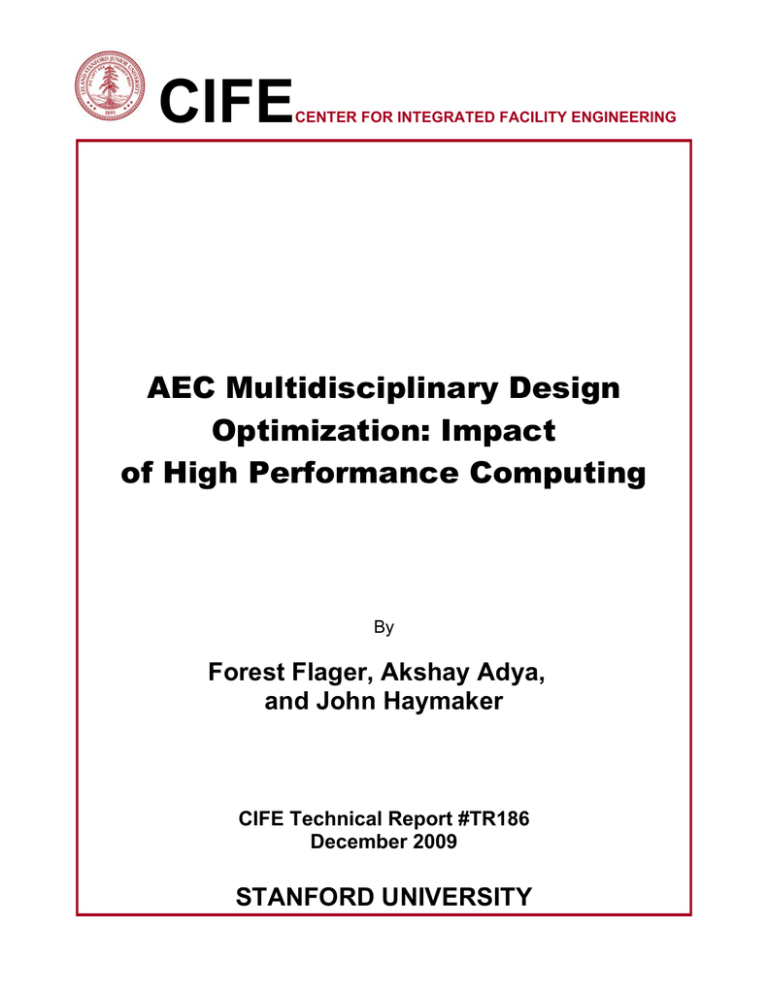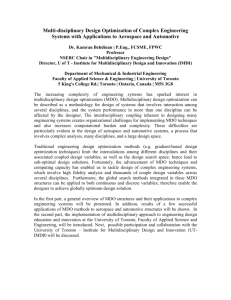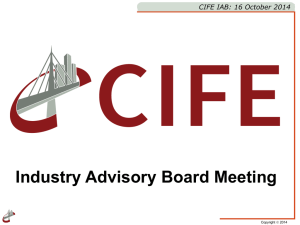CIFE AEC Multidisciplinary Design Optimization: Impact
advertisement

CIFE CENTER FOR INTEGRATED FACILITY ENGINEERING AEC Multidisciplinary Design Optimization: Impact of High Performance Computing By Forest Flager, Akshay Adya, and John Haymaker CIFE Technical Report #TR186 December 2009 STANFORD UNIVERSITY COPYRIGHT © 2009 BY Center for Integrated Facility Engineering If you would like to contact the authors, please write to: c/o CIFE, Civil and Environmental Engineering Dept., Stanford University The Jerry Yang & Akiko Yamazaki Environment & Energy Building 473 Via Ortega, Room 292, Mail Code: 4020 Stanford, CA 94305-4020 CIFE December 16, 2009 AEC Multidisciplinary Design Optimization Impact of High Performance Computing Forest Flager, MEng, MDesS PhD Candidate, Center for Integrated Facility Engineering (CIFE), Stanford University; forest@stanford.edu Akshay Adya, B.S. Graduate Student, Department of Civil and Environmental Engineering, Stanford University; aadya@stanford.edu John Haymaker, PhD, AIA, LEED AP Assistant Professor, Department of Civil and Environmental Engineering, Stanford University; haymaker@stanford.edu 1. Significance of building design It is well known that buildings have a significant impact on our economy and natural environment. In the United States, our current building stock consumes 39% of primary energy, 40% of raw materials and contributes 38% of the nation’s total carbon dioxide emissions [1]. The energy required for lighting, heating and cooling this stock cost our nation’s building owners over $228 billion in 2005 [2]. Current trends in population growth and urbanization suggest that the demand for building space will increase in the future. Much of the life‐cycle economic and environmental costs associated with buildings are determined by their design. There is significant past and current research underway to develop methods by which engineers can measure and predict how a building will perform during its service life. The advancement of Building Information Modeling (BIM) and analysis methods now allows engineers to accurate simulate the performance of structural, mechanical, lighting and other building systems in a virtual environment [3]. However, the potential of these analytic methods and technology to inform design decisions has been limited by the inability of architects and engineers to synthesize this information in a timely manner. Design coordination on Architecture Engineering Construction (AEC) projects is currently an inefficient and time‐consuming process. Many in the field have written about the inability of different disciplines to share data effectively [4‐6]. According to a survey of AEC professionals, it takes a multidisciplinary design team longer than a month to complete a design cycle, which involves generating and analyzing a design option using computer‐based product modeling and simulation methods [7]. The majority of engineers surveyed indicated that they used simulation tools primarily to validate a chosen design option, not to explore multiple alternatives. Consequently, AEC professionals often make design decisions with little or no information about the performance of the chosen design in comparison with 1 CIFE December 16, 2009 other possible alternatives. New design methods are required to explore the design space, or range of possible design options, on a more thorough and systematic basis. 2. MDO research background Researchers in aerospace as well as a variety of other industries (e.g. automotive), have developed a class of methods for Multidisciplinary Design Optimization (MDO) which attempt to formalize problem decomposition and coordination among groups working on the design of complex engineering systems [8]. The goal of these formal methods is to leverage computers’ processing power to enable design exploration that is well beyond unaided human capabilities [9, 10]. The Center for Integrated Facility Engineering (CIFE) at Stanford University is conducting leading research into the development and application of MDO methods in the AEC industry. CIFE researchers have demonstrated that MDO research has the potential to substantially improve the multidisciplinary design in the AEC industry by compressing design cycle time and enabling practitioners to consider orders of magnitude more design options over the course of a project. MDO is a computationally intensive process that involves the automatic execution of various design and simulation‐based software tool that are required multidisciplinary building design. Even for relatively simple MDO problems, the computation time required to complete a trade study on a personal computer can be on the order of hours or days [11]. To address this need, CIFE purchased a 17 node high performance computing cluster in April of 2009. Section 3 describes the high performance computing (HPC) environment that CIFE uses for MDO research. Section 4 describes a test case application of the HPC environment to the structural design of a stadium roof structure. The results of the study demonstrate that the HPC environment enables orders of magnitude reduction in design cycle and computational time required compared to conventional practice and serial execution of the optimization method using a single server, respectively. 3. HPC Environment The HPC environment consists over several components as illustrated in Figure 1. The user first creates integrated system model in ModelCenter® that includes all the necessary engineering design and analysis software required for the design study. ModelCenter allows users bring commercial or proprietary software tools into a common environment using a software “wrapper” or “plug‐in” which interfaces with the tool to be automated. Once an integrated model has been built, ModelCenter’s design exploration and optimization tools can be used to perform optimization and trade‐off studies, and to compare different design options. The user submits a trade study in ModelCenter to the CenterLink® server. CenterLink enables users to accelerate their trade studies by linking to a back‐end compute cluster, while simultaneously providing a centralized storage facility with a built in Web portal to store revision controlled analyses and trade study data. Users can submit jobs from any machine on the network from any machine with ModelCenter. After receiving the data, CenterLink stores the ModelCenter model locally on the file 2 CIFE December 16, 2009 system, and the trade study information in the database. Next, CenterLink sends the trade study request to the Windows HPC load balancing connector. The Windows HPC Connector then communicates directly with the Windows HPC Cluster Manager to submit the execution of each job. A job submitted from the CenterLink Windows HPC Connector consists of running a java process called the TaskWorker Execution Engine (TWEE). The analysis package in the unique folder determines the actual application to be run when the TWEE is executed on a node. Applications can be part of the analysis package or they can also reside in the shared “apps” directory which all nodes can read/write to (this is desirable in the case where the application is large and the overhead of transferring it from CenterLink to the node is prohibitive). After the job is finished, TWEE writes the results in the folder. In the meantime, the CenterLink Windows HPC Connector listens for the jobs to finish, reads the results / returns them to CenterLink, and cleans up the temporary files. CenterLink then returns the results to ModelCenter. The cluster hardware consists of a single ‘master’ server and 16 ‘slave’ servers. The hardware specification for the cluster is described in Table 1 below. The operating system for the cluster is Microsoft Windows HPC Server® 2008. Figure 1: Compute cluster user scenario data flow 3 CIFE Num December 16, 2009 Type Processor Memory Hard Drive OS 1 Master 2 x Quad Core Xeon E5440, 2x6MB Cache 2.83 GHz 1333MHz FSB 32GB 667MHz (8x4GB), Dual Ranked DIMMs 80 GB 7.2K Serial ATA 3Gbps Windows Server ® HPC 16 Slave 2 x Quad Core Xeon E5440, 2x6MB Cache 2.83 GHz 1333MHz FSB 16GB 667MHz (8x2GB), Dual Ranked DIMMs 1 TB 7.2K RPM Universal SATA 3Gbps Windows Server ® HPC Table 1: Computing cluster hardware specification 4. Case study: structural design of a stadium roof structure 4.1. Problem Specification This case study concerns the structural design of a steel frame roof structure for a 65,000 seat athletics stadium (Figure 2). In particular, sizing of structural frame members to minimize cost while satisfying design performance requirements for safety and serviceability. Cost is typically estimated based on the weight of the structure. Since material acquisition is a often a significant portion of the overall construction cost, designs that use a smaller amount of material are thought to be more cost‐efficient, given that the construction methods do not become too expensive or impractical [12]. The member sizing process typically involves first building a detailed finite element analysis (FEA) model of the structure, including a number of design loading combinations and an initial design (i.e. configuration of member sizes) that is determined based on rules of thumb and past experience. The FEA results are then used to calculate a utilization ratio for each member in the structure based on the applicable engineering code of practice. A utilization ratio of less than unity indicates that the strength and serviceability of the member is adequate considering the interaction of axial, bending and torsion forces for a given load case. Based on these results, designers then manually modify the sizes of the members in the structure until all of the strength and deflection constraints are satisfied. Typically engineers select from a discrete set of available steel profiles that are mass produced in a particular nation/region. As the number of members and/or candidate sections increases, the size of the design space or range of possible solutions grows exponentially. Due to the sheer size of the design space, manual methods tend to result in sub‐optimal designs for all but the simplest of structures [13]. In this case, there are 1955 members in the structure. The candidate sections for each member are restricted by group. The design team aggregated members into 34 groups for two reasons. The first is aesthetics: since the roof structure is exposed, the design team wanted to ensure symmetry, continuity, and proportion for visual elements by ensuring the exterior profile of the member sections remained consistent within groups (thickness of sections could vary). The second reason is to simplify the fabrication and erection process by reducing the number of connections between sections with a different exterior cross section. Sample member grouping and associated section types are shown in Figure 2. 4 CIFE December 16, 2009 Rectangular Hollow Section (RHS) Circular Hollow Section (CHS) Universal Beam (UB) Section Figure 2: Building Information Model of the roof structure (TOP). Finite element analysis model and sample member grouping with associated section types (BOTTOM). 4.2. Structural Optimization Process The optimization formulation is as follows: • • • Objective: Minimize total weight of structure Design variables: Sizing for each steel member (1955 variables with 10‐30 candidate sections) Constraints: Steel utilization for each member > 0.8 (1955 total constraints) Thus, the number of unique design configurations (i.e., the size of the design space) is approximately 201955. To make the design exploration process more tractable, Phoenix Integration’s (PHX) ModelCenter software was used to automate many of the tasks that would otherwise have to be performed manually. The following three components were developed to setup the process in ModelCenter as shown in Figure 3: 5 CIFE • • • December 16, 2009 FEA Analysis: Specification of design variables and candidate section values; execution of finite element analysis; calculation of structure weight and constraint values. Postprocessor: Determines the critical constraint for each member (strength or serviceability) Optimizer: Search for the combination of section types that minimizes the global weight of the structure while satisfying the critical constraint. FIG 2: ModelCenter interface showing the structural optimization process 4.3. Benchmarking Results Before CIFE researchers got involved with the project, professional engineers completed 39 design cycles on the stadium roof project before they arrived at a configuration of member sizes that they were satisfied with and planned to submit to the general contractor for tender. This process took approximately 156 man hours using conventional practice methods. Two structural optimization tests were then run using the process described in Section 3.2 above: running the optimizer serially on a single ‘slave’ server and running the optimizer in parallel using the HPC environment described in Section 3 above. The optimizer was run from 128 start points (initial configuration of member sizes) for 100 cycles in each case (6,400 total cycles). The average real time required to complete a design cycle was 5 minutes and 45 seconds in the serial optimization process. This represents a speedup factor of 42 compared to conventional design methods, meaning 42 design cycles can be completed in the serial optimization process in the time it would take to do a single design cycle using conventional methods. The real time elapsed to complete 6 CIFE December 16, 2009 the optimization study serially was 25 days, 13 hours. By parallelizing the optimization process, the optimization study was completed in 6 hours, 42 minutes – a duration that fits within the scheduling constraints of most professional design offices. This represents a speedup factor of 93 compared to the serial optimization and 3,898 compared to conventional methods. These results are summarized in Table 2 below. Real time elapsed (seconds) Design Method Number of processors Number of design cycles Conv. Practice N/A 39 5.62 Serial Opt. 1 12,800 Parallel Opt. (HPC) 128 12,800 total HPC Speedup factor per cycle (average) vs. Conv. Practice vs. Serial Opt. 10 14,400 1 ‐ 4.42 10 345 42 1 4.73 10 3.69 3898 93 Table 2: Speedup with HPC solution The optimization process was able to reduce the structural steel weight of the roof from 1414 to 1146 metric ton while satisfying all of the design constraints, a reduction of 19% compared to conventional methods. This weight reduction equated to a savings of approximately 5 million dollars on the total cost of the steelwork for the roof structure at the time the study was done. 5. Future Research Future structural optimization research will build on this work to allow designers to consider a broader range of design variables including structure shape and topology. CIFE researchers also plan to include additional analyses (e.g. energy performance) into the optimization process. HPC will be a critical resource in this effort as CIFE researchers continue develop and apply MDO methods to large, complex projects in the AEC industry. Acknowledgements The researchers at CIFE would like to thank Microsoft Corporation and Dell for their support of the HPC project – in particular, Efren Mercado and Steven Roach from Microsoft. Also, thanks to CIFEs’ member companies and the Civil Engineering Department at Stanford for their financial support of the cluster purchase. In addition, the author’s would like to acknowledge Steve Jones, Sean Riordan, and Marc Ramsey at Stanford for their technical support in setting up and managing the cluster. Finally, a special thanks to Grant Soremekun, James Mullins, Prashant Sharma and the rest of the Phoenix Integration team for developing and testing the Centerlink – Windows Server HPC connector. 7 CIFE December 16, 2009 References 1. 2. 3. 4. 5. 6. 7. 8. 9. 10. 11. 12. 13. USGBC, Green Building Facts. 2009, U.S. Green Building Council (http://www.usgbc.org): Washington, DC. EIA, Annual Energy Outlook. 2005, Energy Information Administration ‐ Department of Energy (http://www.eia.doe.gov/). Fischer, M., Formalizing Construction Knowledge for Concurrent Performance‐Based Design, in Intelligent Computing in Engineering and Architecture. 2006. p. 186‐205. Gallaher, M.P., et al., Cost Analysis of Inadequate Interoperability in the U.S. Capital Facilities Industry. 2004, National Institute of Standards and Technology: Gaithersburg, Maryland. p. 210. Holzer, D., Y. Tengono, and S. Downing, Developing a Framework for Linking Design Intelligence from Multiple Professions in the AEC Industry, in Computer‐Aided Architectural Design Futures (CAADFutures) 2007. 2007. p. 303‐316. Wang, W., H. Rivard, and R. Zmeureanu, An object‐oriented framework for simulation‐based green building design optimization with genetic algorithms. Advanced Engineering Informatics, 2005. 19(1): p. 5‐23. Flager, F. and J. Haymaker, A Comparison of Multidisciplinary Design, Analysis and Optimization Processes in the Building Construction and Aerospace Industries, in 24th International Conference on Information Technology in Construction, I. Smith, Editor. 2007: Maribor, Slovenia. p. 625‐630 AIAA, Current state of the art in multidisciplinary design optimization. 1991, American Institure for Aeronautics and Astronautics Inc. MDO Technical Committee. Pahl, G., et al., Engineering Design: A Systematic Approach, ed. K. Wallace and L. Blessing. 2007, London: Springer‐Verlag. Vandenbrande, J.H., T.A. Grandine, and T. Hogan, The search for the perfect body: Shape control for multidisciplinary design optimization in 44th AIAA Aerospace Science Meeting and Exhibit. 2006, American Institute of Aeronautics and Astronautics, Inc.: Reno, NV. p. 1‐16. Flager, F., et al., Multidisciplinary Process Integration and Design Optimization of a Classroom Building. Information Technology in Construction, 2009. 15. Nanakorn, P. and K. Meesomklin, An adaptive penalty function in genetic algorithms for structural design optimization. Computers and Structures, 2001. 79(29‐30): p. 2527‐2539. Coello, C., Discrete optimization of trusses using genetic algorithms. Expert Systems Applications and Artificial Intelligence. JG Cheng, FG Attia and DL Crabtree (Editors),(IITT International, Technology Transfer Series), 1994: p. 331‐336. 8


